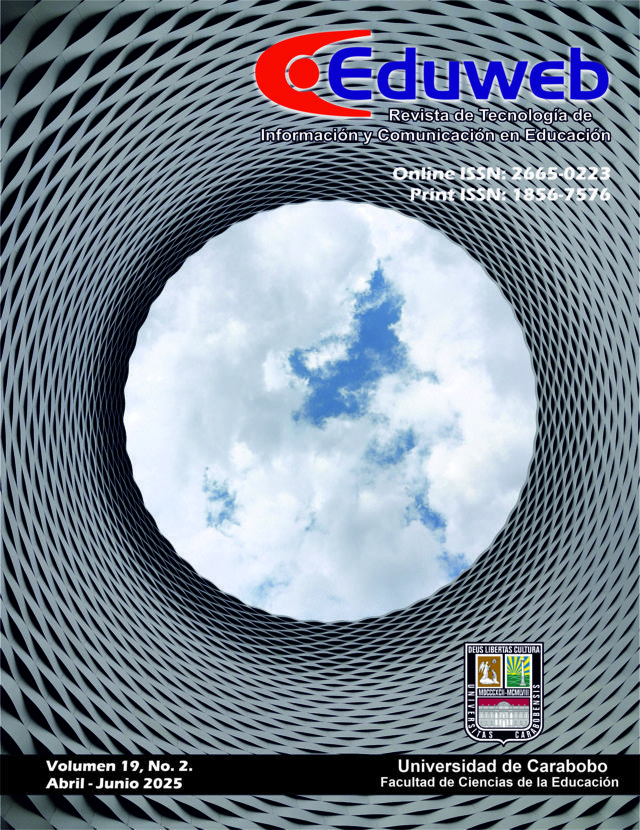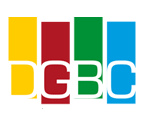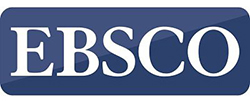La eficacia de los sistemas de proyección/tableros multimedia en la enseñanza de las humanidades
DOI:
https://doi.org/10.46502/issn.1856-7576/2025.19.02.16Palabras clave:
Asignaturas de humanidades, competencias profesionales, pizarras multimedia, sistemas de proyección, tecnologías digitalesResumen
La relevancia del estudio se debe a la necesidad de integrar las tecnologías digitales (pizarras multimedia/sistemas de proyección) en la formación de especialistas, en particular en el ámbito de las humanidades, y en el desarrollo de competencias profesionales mediante el uso de herramientas multimedia modernas. El objetivo del estudio es evaluar la eficacia del uso de pizarras multimedia (PTM) para desarrollar las competencias profesionales de los estudiantes de humanidades. El estudio empleó métodos de análisis teórico y metodológico, generalización de estudios, pruebas, encuestas, trabajo con pizarras interactivas (incluyendo delimitación de espacio, selección de pegatinas, uso de etiquetas y elementos multimedia), etc. El estudio involucró a estudiantes de humanidades, en particular a los de Filología, Educación Primaria y Pedagogía. El número total de participantes fue de 300 estudiantes, que se dividieron en un grupo experimental (GE) de 150 estudiantes) y un grupo de control (GC) de 150 estudiantes. Todos los criterios experimentaron cambios positivos, especialmente en los aspectos de habilidades prácticas (+30%), experiencia con recursos de información (+40%) y el nivel de habilidades comunicativas (+25%). En la fase de control del estudio, se encontraron diferencias estadísticamente significativas entre el GE y el GC en cuanto al nivel de competencia profesional (φcrit=1,64<φemp=2,418). El uso de pizarras virtuales aumenta significativamente el nivel de competencia de los estudiantes, contribuyendo a la interacción activa y a la resolución de tareas prácticas. La encuesta reveló que las tecnologías multimedia aumentan la participación, mejoran la motivación y la comprensión del material (puntuación media: 4,17-4,28). Su flexibilidad en el aprendizaje obtuvo la máxima puntuación (4,28) y sus funciones de personalización, la mínima (3,99). En general, su uso tiene un impacto positivo en el proceso educativo. La novedad académica reside en el uso de pizarras virtuales para el desarrollo de competencias en el actual entorno educativo digital. Futuras investigaciones podrían centrarse en el estudio de la eficacia de las tecnologías interactivas en otras disciplinas de humanidades y su impacto en la formación profesional. The study has a quasi-experimental design, which involves the participation of experimental and control groups without randomisation, but with precise control of variables and comparison of educational outcomes. This approach enables a reasonable assessment of the effectiveness of using multimedia boards and projection systems in developing students' professional competence. The theoretical contribution of the study lies in the development and testing of a pedagogical model for integrating digital tools into humanities education, covering the principles of visualising complex concepts, developing interdisciplinary thinking, active interaction in a digital environment, and individualising learning. The proposed approach can be adapted to other areas of education, taking into account the specifics of subject training.
Citas
Ali, S. (2022). The effectiveness of immersive technologies for future professional education. Futurity Education, 2(2), 13–21. https://doi.org/10.57125/FED/2022.10.11.25
Alzubi, A. (2023). The role of multimedia tools in the Hashemite Kingdom of Jordan's education classroom teaching in the digital era. European Journal of Interactive Multimedia and Education, 4(2), e02303. https://doi.org/10.30935/ejimed/13378
Anggraini, R., & Handayani, Y. (2022). Digitalization in education. Journal of Digital Education, Communication, and Arts, 5(01), 1–12. https://doi.org/10.30871/deca.v5i01.2942
Arguello Mogrovejo, M. T., & Vásquez Guerra, M. (2023). Efectividad de las pizarras digitales interactivas en el proceso de enseñanza-aprendizaje: Un meta-análisis de estudios empíricos. Revista Científica Kosmos, 2(2), 4–17. https://doi.org/10.62943/rck.v2n2.2023.45
Baber, H. (2020). Determinants of students’ perceived learning outcome and satisfaction in online learning during the pandemic of COVID19. Journal of Education and E-Learning Research, 7(3), 285–292. https://doi.org/10.20448/journal.509.2020.73.285.292
Bakhmat, N., Sydoruk, L., Poberezhets, H., Misenyova, V., Boyarova, O., & Mazur, Y. (2023). Features of using the opportunities of the digital environment of the higher educational institution for the development of future economists’ professional competence. Economics Affairs, 68(1s). https://doi.org/10.46852/0424-2513.1s.2023.6
Bruner, J. S. (1966). Toward a theory of instruction (Vol. 59). Harvard University Press. https://acortar.link/3VWwfo
Concha Abarca, J., Quispe Choque, M. E., & Quispe Choque, M. (2023). Importancia del uso de las herramientas digitales en la inclusión educativa. Horizontes. Revista De Investigación En Ciencias De La Educación, 7(29), 1374–1386. https://doi.org/10.33996/revistahorizontes.v7i29.598
Córdova Lapo, R., & Lino Pérez, R. L. (2024). La Interactividad en el proceso de enseñanza y aprendizaje mediada por pizarras virtuales 2.0: Interactivity in the teaching and learning process mediated by virtual whiteboards 2.0. LATAM Revista Latinoamericana De Ciencias Sociales Y Humanidades, 5(6), 1030–1050. https://doi.org/10.56712/latam.v5i6.3063
Devadze, A., Gechbaia, B., & Gvarishvili, N. (2022). Education of the future: an analysis of definitions (literary review). Futurity Education, 2(1), 4–12. https://doi.org/10.57125/FED/2022.10.11.19
Filatova, L., & Drobina, A. (2021). Application of the multimedia technologies in the training of the future primary school teachers. Acta Paedagogica Volynienses, (3), 157–165. https://doi.org/10.32782/apv/2021.3.23
Frumkina, A., Diachenko, M., Polyezhayev, Y., Savina, N., & Hadi, F. (2020). Readiness of future teachers for integrated teaching of educational subjects in foreign language. Revista Práxis Educacional, 16(38), 502-514. Retrieved from https://periodicos2.uesb.br/index.php/praxis/article/view/6023
Gurantz, O., Pender, M., Mabel, Z., Larson C., & Bettinger, E. (2020). Virtual advising for high-achieving high school students. Economics of Education Review, 75. Retrieved from https://ogurantz.github.io/website/Gurantz_2020_VirtualAdvising_EconOfEd.pdf
Gurevych, R. S., Silveistr, A. M., & Мokliuk, M. O. (2020). Use of interactive bask on physics in pedagogical universities. Modern Information Technologies and Innovation Methodologies of Education in Professional Training Methodology Theory Experience Problems, 56, 5-24. https://doi.org/10.31652/2412-1142-2020-56-5-24
Hendawi, M., & Nosair, M. (2020). The efficiency of using the interactive smartboard in social studies to increase students’ achievement and tendency toward the subject matter in the state of Qatar. International Journal of Learning Teaching and Educational Research, 19(3), 1-19. https://doi.org/10.26803/ijlter.19.3.1
Humeniuk, T., & Romaniuk, P. (2023). On the development of information and communication technologies in education of the future: the possibilities of cloud computing technology. Futurity Education, 3(1), 32–41. https://doi.org/10.57125/FED.2023.25.03.03
Khan, D., Rehman, I., Ullah, S., Ahmad, W., Cheng, Z., Jabeen, G., & Kato, H. (2019). A low-cost interactive writing board for primary education using distinct augmented reality markers. Sustainability, 11(20), 5720. https://doi.org/10.3390/su11205720
Khrystiuk, S., & Tsymbal, S. V. (2023). The Role of Information and Communication Technologies in Implementing a Sustainable Development Strategy for Higher Education in Ukraine. Humanitarian Studios: Pedagogics, Psychology, Philosophy, 14(2), 99-106. https://doi.org/10.31548/hspedagog14(2).2023.99-106
Killian, T., & Floren, M. (2020). Exploring the relationship between pedagogy and counselor trainees' multicultural and social justice competence. Journal of Counselling and Development, 98(3), 295–307. https://doi.org/10.1002/jcad.12324
Kraus, S., Durst, S., Ferreira, J. J., Veiga, P., Kailer, N., & Weinmann, A. (2022). Digital transformation in business and management research: An overview of the current status quo. International Journal of Information Management, 63, 102466. https://doi.org/10.1016/j.ijinfomgt.2021.102466
Krymets, L. (2022). What must the education of the future be like to be really future? (Attempts of philosophical reflection). Futurity Philosophy, 1(4), 28–41. https://doi.org/10.57125/FP.2022.12.30.03
Lund, A., & Aagaard, T. (2020). Digitalization of teacher education. Nordic Journal of Comparative and International Education, 4(3-4), 56–71. https://doi.org/10.7577/njcie.3751
O’Leary, E. S., Shapiro, C., Toma, S., Sayson, H. W., Levis-Fitzgerald, M., Johnson, T., & Sork, V. L. (2020). Creating inclusive classrooms by engaging STEM faculty in culturally responsive teaching workshops. International Journal of STEM Education, 7(1). https://doi.org/10.1186/s40594-020-00230-7
Poperechna, G. (2022). The analysis of the philosophical reflection on education of the future peculiarities. Futurity Philosophy, 1(3), 40–51. https://doi.org/10.57125/FP.2022.09.30.03
Rajab, K. D. (2018). The effectiveness and potential of E-learning in war zones: An empirical comparison of face-to-face and online education in Saudi Arabia. IEEE Access, 6, 6783-6794. Retrieved from https://doi.org/10.1109/ACCESS.2018.2800164
Ritter, M. (2022). Digital Games in Primary School English Language Education. English Studies, 33(1), 29–41. https://doi.org/10.33675/angl/2022/1/6
Santoveña-Casal, S., & Fernández Pérez, M. D. (2020). Sustainable Distance Education: Comparison of Digital Pedagogical Models. Sustainability, 12(21), 9067. https://doi.org/10.3390/su12219067
Tang, X., Zainal, S.R.B.M., & Li, Q. (2023). Multimedia use and its impact on the effectiveness of educators: A technology acceptance model perspective. Humanities and Social Sciences Communications, 10, 923. https://doi.org/10.1057/s41599-023-02458-4
Tight, M. (2022). Research into leadership in higher education: A systematic review. In: International perspectives on higher education research (pp. 5–22). Emerald Publishing Limited. https://doi.org/10.1108/s1479-362820220000015001
Vali, I. (2023). The impact of technology on collaborative learning. In: Proceedings of the 9th International Conference EDU WORLD 2022: Education Facing Contemporary World Issues (pp. 1-8). European Publisher. https://doi.org/10.15405/epes.23045.13
Velasteguí López, E. (2019). Las pizarras digitales y su impacto didáctico en la educación superior. Explorador Digital, 3(1), 49-63. https://doi.org/10.33262/exploradordigital.v3i1.346
White, J. R., Yang, T., Muñoz, A. S., & Gao, M. (2023). Digital competence and teaching practices of language teachers in Sweden in a COVID-19 world. In: Digital education and learning (pp. 125–146). Springer International Publishing. https://doi.org/10.1007/978-3-031-12070-1_7
Williams, T. L., Walker, E., Ludlum, M., Edwards, M., & Gregory, K. (2023). Online Learning During the Covid Crisis: Student Views. Journal of Higher Education Theory and Practice, 23(2). https://doi.org/10.33423/jhetp.v23i2.5818
Wong, S. F., Mahmud M. M., & Yong, W. K. (2023). Learning in the margins: Student choice for digital and traditional whiteboards in in-person learning at university. In: Proceedings of the 2023 International Conference on Educational Technologies and Society (pp. 1-9). https://doi.org/10.1145/3637907.3637969
Zhao, K., Peng, C., & Wu, Y. (2024). Exploring the teaching path of visual communication in the digital era. International Journal of Web-Based Learning and Teaching Technologies, 19(1), 1-17. https://doi.org/10.4018/IJWLTT.340937
Zhylin, M., Tormanova, A., Poplavska, Y., Chernov, M. M., & Druz, O. (2023). Study of digital approach in education and psychology among selected users in Ukraine. Multidisciplinary Reviews, 6. https://doi.org/10.31893/multirev.2023spe007
Descargas
Publicado
Cómo citar
Número
Sección
Licencia
Derechos de autor 2025 Natalia Romanyshyna, Nataliіa Matveieva, Alexander Chinchoy, Viktoriia Savitska, Yurii Sakh

Esta obra está bajo una licencia internacional Creative Commons Atribución 4.0.















